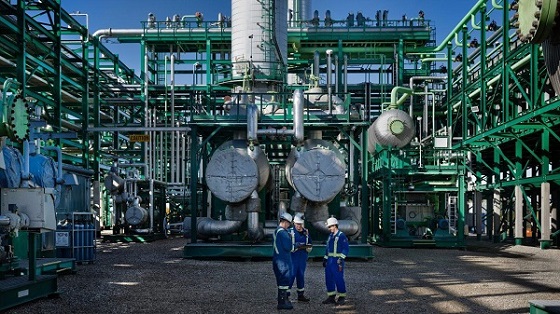Alberta
Alberta providing additional $7 million to Grande Prairie to help transition to municipal police service

Supporting homegrown policing solutions
Alberta’s government is following through on a commitment to ensure that communities can pursue policing solutions that meet their needs and are supported in reaching their public safety goals. That’s why the province is supporting the City of Grande Prairie with an additional $7 million in funding as it transitions to a municipal police service, helping to advance a homegrown solution that meets the needs of the community.
This new funding reinforces and builds on the province’s initial $9.7 million two-year commitment to help the City of Grande Prairie meet its policing and public safety needs, following the city council’s decision in March 2023 to transition from the RCMP to a municipal police service.
“Alberta’s government will do whatever it takes to keep people safe. The City of Grande Prairie is pursuing a policing solution that’s right for the community and its residents, and Alberta’s government is behind them throughout the transition process. Albertans, regardless of where they live, deserve fast and reliable law enforcement where and when they need it. Our government remains committed to ensuring Alberta municipalities have their choice of policing provider.”
Since 2023, Grande Prairie has made significant progress in hiring officers and civilian staff, procuring equipment, and beginning the development of essential IT infrastructure for a municipal police service. This support from the province ensures that the city can keep the momentum of its transition going as it lays critical groundwork for the Grande Prairie Police Service (GPPS).
The funding will support the projected start-up costs associated with building and implementing the new service, including salaries, benefits, recruitment, equipment and training. The GPPS is expected to become the primary police service of jurisdiction for Grande Prairie in 2026.
Once provincial startup funding through the Grande Prairie Police Service Grant agreement ends, the city will absorb all operational costs associated with its new police service. The annual operating budget of the GPPS is projected to be less than those associated with policing services contracted through the RCMP.
“The City of Grande Prairie is thankful for this announcement and the ongoing funding and support from the provincial government as we transition to a municipal police service. The transition is on budget and on schedule and has already provided a positive impact on our community safety and valuable insights on the modernizations that will be achieved with a stand-alone municipal police service model.”
“With the ongoing support and funding from the Alberta government, we are creating a modern, community-oriented police service that reflects the unique needs of Grande Prairie. The Grande Prairie Police Service is quickly proving that a policing transition can be both effective and efficient.”
Key facts
- The projected total cost of establishing and implementing the GPPS is $19 million.
- The GPPS is expected to become the primary police of jurisdiction for Grande Prairie in 2026.
- Through the Indigenous and Municipal Police Transition Study Grant program, Alberta’s government delivered more than $2.2 million in funding to help 35 municipalities, 23 First Nations and eight Metis Settlements to explore ways to enhance their existing policing models as well as alternate options such as self-administered First Nations policing or standalone police services.
- Under Alberta’s Police Act, towns and cities with populations greater than 5,000 are responsible for their own policing and can form their own municipal police service, be part of a regional policing arrangement or contract with the federal government for RCMP policing services to meet their public safety needs.
Related news
- Alberta funds community policing in Grande Prairie (Feb 22, 2023)
Alberta
Cross-Canada NGL corridor will stretch from B.C. to Ontario

Keyera Corp.’s natural gas liquids facilities in Fort Saskatchewan. Photo courtesy Keyera Corp.
From the Canadian Energy Centre
By Will Gibson
Keyera ‘Canadianizes’ natural gas liquids with $5.15 billion acquisition
Sarnia, Ont., which sits on the southern tip of Lake Huron and peers across the St. Clair River to Michigan, is a crucial energy hub for much of the eastern half of Canada and parts of the United States.
With more than 60 industrial facilities including refineries and chemical plants that produce everything from petroleum, resins, synthetic rubber, plastics, lubricants, paint, cosmetics and food additives in the southwestern Ontario city, Mayor Mike Bradley admits the ongoing dialogue about tariffs with Canada’s southern neighbour hits close to home.
So Bradley welcomed the announcement that Calgary-based Keyera Corp. will acquire the majority of Plains American Pipelines LLP’s Canadian natural gas liquids (NGL) business, creating a cross-Canada NGL corridor that includes a storage hub in Sarnia.
“As a border city, we’ve been on the frontline of the tariff wars, so we support anything that helps enhance Canadian sovereignty and jobs,” says the long-time mayor, who was first elected in 1988.
The assets in Sarnia are a key piece of the $5.15 billion transaction, which will connect natural gas liquids from the growing Montney and Duvernay plays in B.C. and Alberta to markets in central Canada and the eastern U.S. seaboard.
NGLs are hydrocarbons found within natural gas streams including ethane, propane and pentanes. They are important energy sources and used to produce a wide range of everyday items, from plastics and clothing to fuels.
Keyera CEO Dean Setoguchi cast the proposed acquisition as an act of repatriation.
“This transaction brings key NGL infrastructure under Canadian ownership, enhancing domestic energy capabilities and reinforcing Canada’s economic resilience by keeping value and decision-making closer to home,” Setoguchi told analysts in a June 17 call.
“Plains’ portfolio forms a fully integrated cross Canada NGL system connecting Western Canada supply to key demand centres across the Prairie provinces, Ontario and eastern U.S.,” he said.
“The system includes strategic hubs like Empress, Fort Saskatchewan and Sarnia – which provide a reliable source of Canadian NGL supply to extensive fractionation, storage, pipeline and logistics infrastructure.”
Martin King, RBN Energy’s managing director of North America Energy Market Analysis, sees Keyera’s ability to “Canadianize” its NGL infrastructure as improving the company’s growth prospects.
“It allows them to tap into the Duvernay and Montney, which are the fastest growing NGL plays in North America and gives them some key assets throughout the country,” said the Calgary-based analyst.
“The crown assets are probably the straddle plants in Empress, which help strip out the butane, ethane and other liquids for condensate. It also positions them well to serve the eastern half of the country.”
And that’s something welcomed in Sarnia.
“Having a Canadian source for natural gas would be our preference so we see Keyera’s acquisition as strengthening our region as an energy hub,” Bradley said.
“We are optimistic this will be good for our region in the long run.”
The acquisition is expected to close in the first quarter of 2026, pending regulatory approvals.
Meanwhile, the governments of Ontario and Alberta are joining forces to strengthen the economies of both regions, and the country, by advancing major infrastructure projects including pipelines, ports and rail.
A joint feasibility study is expected this year on how to move major private sector-led investments forward.
Alberta
Alberta school boards required to meet new standards for school library materials with regard to sexual content

Alberta’s government has introduced new standards to ensure school library materials are age-appropriate.
School libraries should be safe and supportive places where students can learn and explore without being exposed to inappropriate sexual content. However, in the absence of a consistent standard for selecting age-appropriate library materials, school boards have taken different approaches, leading to concerns about safeguards in place.
In response to these concerns, and informed by feedback from education partners and the public, Alberta’s government has created standards to provide school boards with clear direction on the selection, availability and access to school library materials, such as books.
“Our actions to ensure that materials in school libraries don’t expose children to sexual content were never about banning books. These new standards are to ensure that school boards have clear guidance to ensure age-appropriate access to school library materials, while reflecting the values and priorities of Albertans.”
The new standards set clear expectations for school library materials with regard to sexual content and require school boards to implement policies to support these standards.
Standards for school library materials
Under the new standards, school libraries are not permitted to include library materials containing explicit sexual content. Non-explicit sexual content may be accessible to students in Grade 10 and above, provided it is age-appropriate.
“Protecting kids from explicit content is common sense. LGBTQ youth, like all children, deserve to see themselves in stories that are age-appropriate, supportive and affirming – not in material that sexualizes or confuses them.”
School boards must also regularly review their school library collections, publish a full list of available materials and ensure that a staff member supervises students’ access to school library materials. School boards will have to remove any materials with explicit sexual content from their school libraries by October 1.
School board policies and procedures
All school boards must have publicly available policies that align with the new standards for selecting and managing library materials by January 1, 2026. School boards can either create new policies or update existing ones to meet these requirements.
These policies must outline how school library materials are selected and reviewed, how staff supervise students’ access throughout the school day, and how a student, parent, school board employee or other member of the school community can request a review or removal of materials in the school library. School boards are also required to clearly communicate these policies to employees, students and parents before January 2026.
“A robust, grade- and age-appropriate library catalogue is vital for student success. We welcome the ministry’s initiative to establish consistent standards and appreciate the ongoing consultation to help craft a plan that will serve our families and communities well.”
“Red Deer Public Schools welcomes the new provincial standards for school library materials. Our division is committed to maintaining welcoming, respectful learning spaces where students can grow and thrive. Under the new standards for school libraries, we remain dedicated to providing learning resources that reflect our values and support student success.”
Quick facts
- The new standards will apply to public, separate, francophone, charter and independent schools.
- The ministerial order does not apply to municipal libraries located within schools or materials selected for use by teachers as learning and teaching resources.
- From May 26 to June 6, almost 80,000 people completed an online survey to provide feedback on the creation of consistent standards to ensure the age-appropriateness of materials available to students in school libraries.
Related information
- Ministerial Order
- School library standards engagement
- Reference Materials: Content warning: this document contains graphic content that may be disturbing to viewers and is not appropriate for young viewers. Viewer discretion is advised.
-

 Crime2 days ago
Crime2 days agoSweeping Boston Indictment Points to Vast Chinese Narco-Smuggling and Illegal Alien Labor Plot via Mexican Border
-

 Business14 hours ago
Business14 hours agoMost Canadians say retaliatory tariffs on American goods contribute to raising the price of essential goods at home
-

 Alberta14 hours ago
Alberta14 hours agoCross-Canada NGL corridor will stretch from B.C. to Ontario
-

 National22 hours ago
National22 hours agoWomen and girls beauty pageant urges dismissal of transgender human rights complaint
-

 International1 day ago
International1 day agoSupport for the Ukraine war continues because no one elected is actually in charge.
-

 Business1 day ago
Business1 day agoTrump slaps Brazil with tariffs over social media censorship
-

 Business2 days ago
Business2 days agoCBC six-figure salaries soar
-

 Environment2 days ago
Environment2 days agoEPA releases report on chemtrails, climate manipulation




